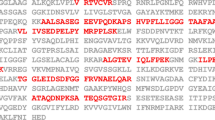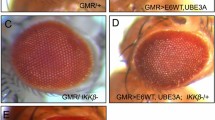Abstract
Cancer cells are insensitive to many signals that inhibit growth of untransformed cells. Here, we show that primary human epithelial cells expressing human papillomavirus (HPV) type-16 E6/E7 bypass arrest caused by the DNA-damaging drug adriamycin and become tetraploid. To determine the contribution of E6 in the context of E7 to the resistance of arrest and induction of tetraploidy, we used an E6 mutant unable to degrade p53 or RNAi targeting p53 for knockdown. The E6 mutant fails to generate tetraploidy; however, the presence of E7 is sufficient to bypass arrest while the p53 RNAi permits both arrest insensitivity and tetraploidy. We published previously that polo-like kinase 1 (Plk1) is upregulated in E6/E7-expressing cells. We observe here that abnormal expression of Plk1 protein correlates with tetraploidy. Using the p53 binding-defective mutant of E6 and p53 RNAi, we show that p53 represses Plk1, suggesting that loss of p53 results in tetraploidy through upregulation of Plk1. Consistent with this hypothesis, overexpression of Plk1 in cells generates tetraploidy but does not confer resistance to arrest. These results support a model for transformation caused by HPV-16 where bypass of arrest and tetraploidy are separable consequences of p53 loss with Plk1 required only for the latter effect.
This is a preview of subscription content, access via your institution
Access options
Subscribe to this journal
Receive 50 print issues and online access
$259.00 per year
only $5.18 per issue
Buy this article
- Purchase on Springer Link
- Instant access to full article PDF
Prices may be subject to local taxes which are calculated during checkout






Similar content being viewed by others
References
Brummelkamp TR, Bernards R, Agami R . (2002). Science 296: 550–553.
Burd EM . (2003). Clin Microbiol Rev 16: 1–17.
Cahill DP, Lengauer C, Yu J, Riggins GJ, Willson JK, Markowitz SD et al. (1998). Nature 392: 300–303.
Cross SM, Sanchez CA, Morgan CA, Schimke MK, Ramel S, Idzerda RL et al. (1995). Science 267: 1353–1356.
Demers GW, Espling E, Harry JB, Etscheid BG, Galloway DA . (1996). J Virol 70: 6862–6869.
Dyson N, Howley PM, Munger K, Harlow E . (1989). Science 243: 934–937.
Eichten A, Westfall M, Pietenpol JA, Munger K . (2002). Virology 295: 74–85.
Flatt PM, Price JO, Shaw A, Pietenpol JA . (1998). Cell Growth Differ 9: 535–543.
Foster SA, Demers GW, Etscheid BG, Galloway DA . (1994). J Virol 68: 5698–5705.
Galipeau PC, Cowan DS, Sanchez CA, Barrett MT, Emond MJ, Levine DS et al. (1996). Proc Natl Acad Sci USA 93: 7081–7084.
Guan R, Tapang P, Leverson JD, Albert D, Giranda VL, Luo Y . (2005). Cancer Res 65: 2698–2704.
Hanks S, Coleman K, Reid S, Plaja A, Firth H, Fitzpatrick D et al. (2004). Nat Genet 36: 1159–1161.
Hawley-Nelson P, Vousden KH, Hubbert NL, Lowy DR, Schiller JT . (1989). EMBO J 8: 3905–3910.
Jackson MW, Agarwal MK, Yang J, Bruss P, Uchiumi T, Agarwal ML et al. (2005). J Cell Sci 118: 1821–1832.
Kho PS, Wang Z, Zhuang L, Li Y, Chew JL, Ng HH et al. (2004). J Biol Chem 279: 21183–21192.
Knecht R, Elez R, Oechler M, Solbach C, von Ilberg C, Strebhardt K . (1999). Cancer Res 59: 2794–2797.
Lanni JS, Jacks T . (1998). Mol Cell Biol 18: 1055–1064.
McMurray HR, McCance DJ . (2004). J Virol 78: 5698–5706.
Meraldi P, Honda R, Nigg EA . (2002). EMBO J 21: 483–492.
Michel L, Diaz-Rodriguez E, Narayan G, Hernando E, Murty VV, Benezra R . (2004). Proc Natl Acad Sci USA 101: 4459–4464.
Morgenstern JP, Land H . (1990). Nucleic Acids Res 18: 3587–3596.
Mundt KE, Golsteyn RM, Lane HA, Nigg EA . (1997). Biochem Biophys Res Commun 239: 377–385.
Munger K, Phelps WC, Bubb V, Howley PM, Schlegel R . (1989). J Virol 63: 4417–4421.
Nigg EA . (2001). Nat Rev Mol Cell Biol 2: 21–32.
Patel D, Incassati A, Wang N, McCance DJ . (2004). Cancer Res 64: 1299–1306.
Scheffner M, Werness BA, Huibregtse JM, Levine AJ, Howley PM . (1990). Cell 63: 1129–1136.
Smits VA, Klompmaker R, Arnaud L, Rijksen G, Nigg EA, Medema RH . (2000). Nat Cell Biol 2: 672–676.
Southern SA, Lewis MH, Herrington CS . (2004). Br J Cancer 90: 1949–1954.
Spankuch-Schmitt B, Bereiter-Hahn J, Kaufmann M, Strebhardt K . (2002). J Natl Cancer Inst 94: 1863–1877.
Storchova Z, Pellman D . (2004). Nat Rev Mol Cell Biol 5: 45–54.
Thomas JT, Laimins LA . (1998). J Virol 72: 1131–1137.
Thompson DA, Belinsky G, Chang TH, Jones DL, Schlegel R, Munger K . (1997). Oncogene 15: 3025–3035.
Weichert W, Denkert C, Schmidt M, Gekeler V, Wolf G, Kobel M et al. (2004). Br J Cancer 90: 815–821.
Weichert W, Kristiansen G, Winzer KJ, Schmidt M, Gekeler V, Noske A et al. (2005). Virchows Arch 446: 442–450.
Werness BA, Levine AJ, Howley PM . (1990). Science 248: 76–79.
zur Hausen H . (2000). J Natl Cancer Inst 92: 690–698.
Acknowledgements
We sincerely thank Dirk Bohmann, Jiyong Zhao, and McCance lab members for critical reading of the manuscript. This work was funded by NIH Grant NIDCR DE13526 to DJ M. AI was supported by the Rochester Training Program in Oral Infectious Diseases (T32-DE07165).
Author information
Authors and Affiliations
Corresponding author
Rights and permissions
About this article
Cite this article
Incassati, A., Patel, D. & McCance, D. Induction of tetraploidy through loss of p53 and upregulation of Plk1 by human papillomavirus type-16 E6. Oncogene 25, 2444–2451 (2006). https://doi.org/10.1038/sj.onc.1209276
Received:
Revised:
Accepted:
Published:
Issue Date:
DOI: https://doi.org/10.1038/sj.onc.1209276
Keywords
This article is cited by
-
Papillomaviruses and cancer: commonalities and differences in HPV carcinogenesis at different sites of the body
International Journal of Clinical Oncology (2023)
-
Efficient immortalization of cells derived from critically endangered Tsushima leopard cat (Prionailurus bengalensis euptilurus) with expression of mutant CDK4, Cyclin D1, and telomerase reverse transcriptase
Cytotechnology (2018)
-
Long noncoding RNA lnc-RI is a new regulator of mitosis via targeting miRNA-210-3p to release PLK1 mRNA activity
Scientific Reports (2016)
-
Comprehensive Profiling of EGFR/HER Receptors for Personalized Treatment of Gynecologic Cancers
Molecular Diagnosis & Therapy (2014)
-
Immunohistochemical detection of Polo-like kinase-1 (PLK1) in primary breast cancer is associated with TP53mutation and poor clinical outcome
Breast Cancer Research (2012)



